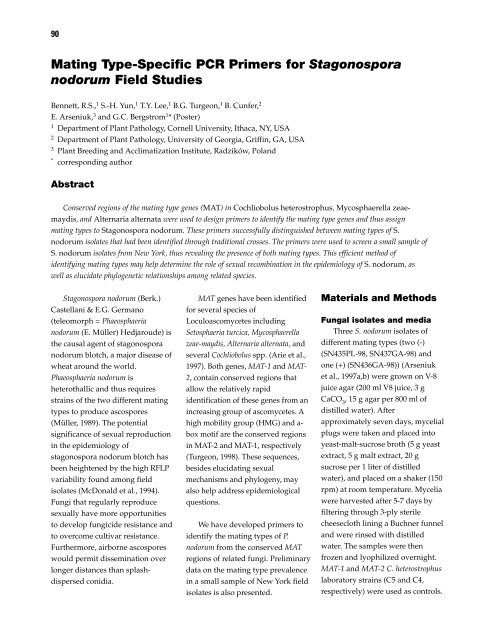Septoria and Stagonospora Diseases of Cereals - CIMMYT ...
Septoria and Stagonospora Diseases of Cereals - CIMMYT ...
Septoria and Stagonospora Diseases of Cereals - CIMMYT ...
You also want an ePaper? Increase the reach of your titles
YUMPU automatically turns print PDFs into web optimized ePapers that Google loves.
90<br />
Mating Type-Specific PCR Primers for <strong>Stagonospora</strong><br />
nodorum Field Studies<br />
Bennett, R.S., 1 S.-H. Yun, 1 T.Y. Lee, 1 B.G. Turgeon, 1 B. Cunfer, 2<br />
E. Arseniuk, 3 <strong>and</strong> G.C. Bergstrom 1 * (Poster)<br />
1 Department <strong>of</strong> Plant Pathology, Cornell University, Ithaca, NY, USA<br />
2 Department <strong>of</strong> Plant Pathology, University <strong>of</strong> Georgia, Griffin, GA, USA<br />
3 Plant Breeding <strong>and</strong> Acclimatization Institute, Radzików, Pol<strong>and</strong><br />
* corresponding author<br />
Abstract<br />
Conserved regions <strong>of</strong> the mating type genes (MAT) in Cochliobolus heterostrophus, Mycosphaerella zeaemaydis,<br />
<strong>and</strong> Alternaria alternata were used to design primers to identify the mating type genes <strong>and</strong> thus assign<br />
mating types to <strong>Stagonospora</strong> nodorum. These primers successfully distinguished between mating types <strong>of</strong> S.<br />
nodorum isolates that had been identified through traditional crosses. The primers were used to screen a small sample <strong>of</strong><br />
S. nodorum isolates from New York, thus revealing the presence <strong>of</strong> both mating types. This efficient method <strong>of</strong><br />
identifying mating types may help determine the role <strong>of</strong> sexual recombination in the epidemiology <strong>of</strong> S. nodorum, as<br />
well as elucidate phylogenetic relationships among related species.<br />
<strong>Stagonospora</strong> nodorum (Berk.)<br />
Castellani & E.G. Germano<br />
(teleomorph = Phaeosphaeria<br />
nodorum (E. Müller) Hedjaroude) is<br />
the causal agent <strong>of</strong> stagonospora<br />
nodorum blotch, a major disease <strong>of</strong><br />
wheat around the world.<br />
Phaeosphaeria nodorum is<br />
heterothallic <strong>and</strong> thus requires<br />
strains <strong>of</strong> the two different mating<br />
types to produce ascospores<br />
(Müller, 1989). The potential<br />
significance <strong>of</strong> sexual reproduction<br />
in the epidemiology <strong>of</strong><br />
stagonospora nodorum blotch has<br />
been heightened by the high RFLP<br />
variability found among field<br />
isolates (McDonald et al., 1994).<br />
Fungi that regularly reproduce<br />
sexually have more opportunities<br />
to develop fungicide resistance <strong>and</strong><br />
to overcome cultivar resistance.<br />
Furthermore, airborne ascospores<br />
would permit dissemination over<br />
longer distances than splashdispersed<br />
conidia.<br />
MAT genes have been identified<br />
for several species <strong>of</strong><br />
Loculoascomycetes including<br />
Setosphaeria turcica, Mycosphaerella<br />
zeae-maydis, Alternaria alternata, <strong>and</strong><br />
several Cochliobolus spp. (Arie et al.,<br />
1997). Both genes, MAT-1 <strong>and</strong> MAT-<br />
2, contain conserved regions that<br />
allow the relatively rapid<br />
identification <strong>of</strong> these genes from an<br />
increasing group <strong>of</strong> ascomycetes. A<br />
high mobility group (HMG) <strong>and</strong> abox<br />
motif are the conserved regions<br />
in MAT-2 <strong>and</strong> MAT-1, respectively<br />
(Turgeon, 1998). These sequences,<br />
besides elucidating sexual<br />
mechanisms <strong>and</strong> phylogeny, may<br />
also help address epidemiological<br />
questions.<br />
We have developed primers to<br />
identify the mating types <strong>of</strong> P.<br />
nodorum from the conserved MAT<br />
regions <strong>of</strong> related fungi. Preliminary<br />
data on the mating type prevalence<br />
in a small sample <strong>of</strong> New York field<br />
isolates is also presented.<br />
Materials <strong>and</strong> Methods<br />
Fungal isolates <strong>and</strong> media<br />
Three S. nodorum isolates <strong>of</strong><br />
different mating types (two (-)<br />
(SN435PL-98, SN437GA-98) <strong>and</strong><br />
one (+) (SN436GA-98)) (Arseniuk<br />
et al., 1997a,b) were grown on V-8<br />
juice agar (200 ml V8 juice, 3 g<br />
CaCO3 , 15 g agar per 800 ml <strong>of</strong><br />
distilled water). After<br />
approximately seven days, mycelial<br />
plugs were taken <strong>and</strong> placed into<br />
yeast-malt-sucrose broth (5 g yeast<br />
extract, 5 g malt extract, 20 g<br />
sucrose per 1 liter <strong>of</strong> distilled<br />
water), <strong>and</strong> placed on a shaker (150<br />
rpm) at room temperature. Mycelia<br />
were harvested after 5-7 days by<br />
filtering through 3-ply sterile<br />
cheesecloth lining a Buchner funnel<br />
<strong>and</strong> were rinsed with distilled<br />
water. The samples were then<br />
frozen <strong>and</strong> lyophilized overnight.<br />
MAT-1 <strong>and</strong> MAT-2 C. heterostrophus<br />
laboratory strains (C5 <strong>and</strong> C4,<br />
respectively) were used as controls.









